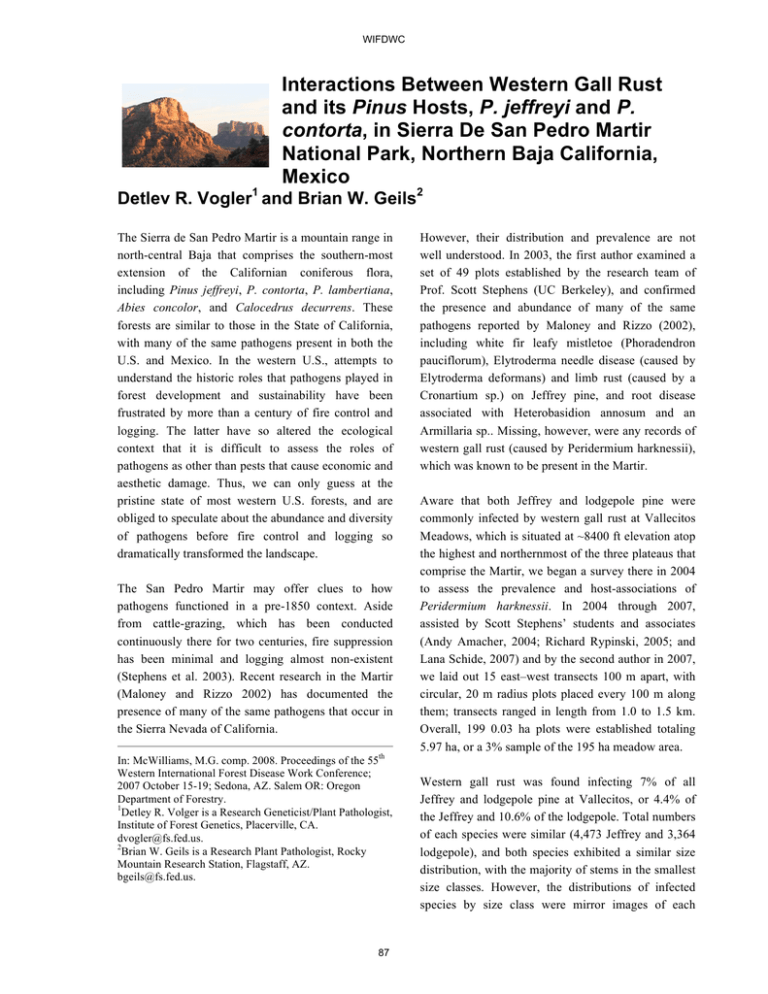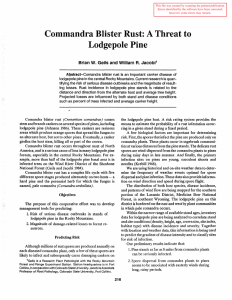Interactions Between Western Gall Rust Pinus National Park, Northern Baja California, Mexico
advertisement

WIFDWC Interactions Between Western Gall Rust and its Pinus Hosts, P. jeffreyi and P. contorta, in Sierra De San Pedro Martir National Park, Northern Baja California, Mexico Detlev R. Vogler1 and Brian W. Geils2 The Sierra de San Pedro Martir is a mountain range in north-central Baja that comprises the southern-most extension of the Californian coniferous flora, including Pinus jeffreyi, P. contorta, P. lambertiana, Abies concolor, and Calocedrus decurrens. These forests are similar to those in the State of California, with many of the same pathogens present in both the U.S. and Mexico. In the western U.S., attempts to understand the historic roles that pathogens played in forest development and sustainability have been frustrated by more than a century of fire control and logging. The latter have so altered the ecological context that it is difficult to assess the roles of pathogens as other than pests that cause economic and aesthetic damage. Thus, we can only guess at the pristine state of most western U.S. forests, and are obliged to speculate about the abundance and diversity of pathogens before fire control and logging so dramatically transformed the landscape. The San Pedro Martir may offer clues to how pathogens functioned in a pre-1850 context. Aside from cattle-grazing, which has been conducted continuously there for two centuries, fire suppression has been minimal and logging almost non-existent (Stephens et al. 2003). Recent research in the Martir (Maloney and Rizzo 2002) has documented the presence of many of the same pathogens that occur in the Sierra Nevada of California. In: McWilliams, M.G. comp. 2008. Proceedings of the 55th Western International Forest Disease Work Conference; 2007 October 15-19; Sedona, AZ. Salem OR: Oregon Department of Forestry. 1 Detley R. Volger is a Research Geneticist/Plant Pathologist, Institute of Forest Genetics, Placerville, CA. dvogler@fs.fed.us. 2 Brian W. Geils is a Research Plant Pathologist, Rocky Mountain Research Station, Flagstaff, AZ. bgeils@fs.fed.us. 87 However, their distribution and prevalence are not well understood. In 2003, the first author examined a set of 49 plots established by the research team of Prof. Scott Stephens (UC Berkeley), and confirmed the presence and abundance of many of the same pathogens reported by Maloney and Rizzo (2002), including white fir leafy mistletoe (Phoradendron pauciflorum), Elytroderma needle disease (caused by Elytroderma deformans) and limb rust (caused by a Cronartium sp.) on Jeffrey pine, and root disease associated with Heterobasidion annosum and an Armillaria sp.. Missing, however, were any records of western gall rust (caused by Peridermium harknessii), which was known to be present in the Martir. Aware that both Jeffrey and lodgepole pine were commonly infected by western gall rust at Vallecitos Meadows, which is situated at ~8400 ft elevation atop the highest and northernmost of the three plateaus that comprise the Martir, we began a survey there in 2004 to assess the prevalence and host-associations of Peridermium harknessii. In 2004 through 2007, assisted by Scott Stephens’ students and associates (Andy Amacher, 2004; Richard Rypinski, 2005; and Lana Schide, 2007) and by the second author in 2007, we laid out 15 east–west transects 100 m apart, with circular, 20 m radius plots placed every 100 m along them; transects ranged in length from 1.0 to 1.5 km. Overall, 199 0.03 ha plots were established totaling 5.97 ha, or a 3% sample of the 195 ha meadow area. Western gall rust was found infecting 7% of all Jeffrey and lodgepole pine at Vallecitos, or 4.4% of the Jeffrey and 10.6% of the lodgepole. Total numbers of each species were similar (4,473 Jeffrey and 3,364 lodgepole), and both species exhibited a similar size distribution, with the majority of stems in the smallest size classes. However, the distributions of infected species by size class were mirror images of each WIFDWC 55, 2007 other: most of the infected Jeffrey pines were in the smaller size classes (< 12” diameter), whereas the majority of the infected lodgepole pines were in the larger size classes (!13” diameter). These reciprocal host distributions suggest that western gall rust may regulate the success of Jeffrey pine relative to lodgepole by posing a challenge to survival of Jeffrey seedlings and saplings where lodgepole are already present, since Jeffrey reproduction would be exposed to a rain of spores from infected lodgepole overstory. Further investigations are needed to test this and alternative hypotheses. Does western gall rust maintain a fluctuating equilibrium between the distributions and abundance of the two pine species? Since fire is an active and frequent agent in these forests, the relative susceptibilities of Jeffrey and lodgepole regeneration to fire may also be significant. At present, it appears that western gall rust plays a role in facilitating the invasion of Jeffrey stands by lodgepole pine, and perhaps vice versa. However, the relative susceptibilities of the two species to the gall rust pathogen may counter-balance these effects, but this needs to be confirmed experimentally. We observed that Jeffrey pine seedlings that were establishing beneath the crowns of infected lodgepole were often not infected. Were they escaping inoculation by “sheltering” beneath the lodgepole crowns, or were they more resistant to the pathogen? Finally, those few remaining forest lands that have experienced little logging or fire suppression should be preserved and studied if we are ever to understand the historical roles of pathogens in forest succession and sustainability. While treating pathogens solely as pests to be controlled may suffice for production forestry, forest management for ecosystem, recreational, and aesthetic values requires a deeper appreciation of the beneficial roles of pathogens. !"#"$"%&"'(( Maloney, P.E., Rizzo, D.M. 2002. Pathogens and insects in a pristine forest ecosystem: the Sierra San Pedro Martir, Baja, Mexico. Candian Journal of Forest Research 32: 448-457. Stephens, S.L., Skinner, C.N., Gill, S.J. 2003. Dendrochronology-based fire history of Jeffrey pine –mixed conifer forests in the Sierra San Pedro Martir, Mexico. Canadian Journal of Forest Research 33: 1090-1101. 88


